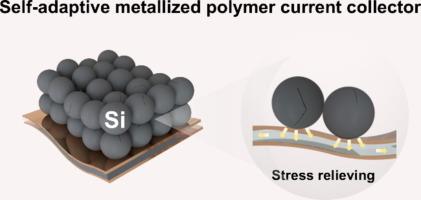Metallized polymer current collector as “stress acceptor” for stable micron-sized silicon anodes
IF 13.1
1区 化学
Q1 Energy
引用次数: 0
Abstract
Micron-sized silicon (μSi) is a promising anode material for next-generation lithium-ion batteries due to its high specific capacity, low cost, and abundant reserves. However, the volume expansion that occurs during cycling leads to the accumulation of undesirable stresses, resulting in pulverization of silicon microparticles and shortened lifespan of the batteries. Herein, a composite film of Cu-PET-Cu is proposed as the current collector (CC) for μSi anodes to replace the conventional Cu CC. Cu-PET-Cu CC is prepared by depositing Cu on both sides of a polyethylene terephthalate (PET) film. The PET layer promises good ductility of the film, permitting the Cu-PET-Cu CC to accommodate the volumetric changes of silicon microparticles and facilitates the stress release through ductile deformation. As a result, the μSi electrode with Cu-PET-Cu CC retains a high specific capacity of 2181 mA h g−1, whereas the μSi electrode with Cu CC (μSi/Cu) exhibits a specific capacity of 1285 mA h g−1 after 80 cycles. The stress relieving effect of Cu-PET-Cu was demonstrated by in-situ fiber optic stress monitoring and multi-physics simulations. This work proposes an effective stress relief strategy at the electrode level for the practical implementation of μSi anodes.

金属化聚合物集流器作为稳定的微米级硅阳极的 "应力接收器
微米级硅 (μSi)具有比容量高、成本低和储量丰富等优点,是下一代锂离子电池的理想负极材料。然而,在循环过程中发生的体积膨胀会导致不良应力的积累,从而导致硅微颗粒的粉碎和电池寿命的缩短。本文提出了一种 Cu-PET-Cu 复合薄膜作为微硅阳极的集流器(CC),以取代传统的 Cu CC。Cu-PET-Cu CC 是通过在聚对苯二甲酸乙二醇酯(PET)薄膜的两面沉积铜来制备的。PET 层保证了薄膜的良好延展性,使 Cu-PET-Cu CC 能够适应硅微颗粒的体积变化,并通过延展变形促进应力释放。因此,带有 Cu-PET-Cu CC 的微硅电极在 80 个循环后仍能保持 2181 mA h g-1 的高比容量,而带有 Cu CC 的微硅电极(μSi/Cu)的比容量为 1285 mA h g-1。原位光纤应力监测和多物理场仿真证明了 Cu-PET-Cu 的应力消除效果。这项研究提出了一种有效的电极应力消除策略,可用于μSi 阳极的实际应用。
本文章由计算机程序翻译,如有差异,请以英文原文为准。
求助全文
约1分钟内获得全文
求助全文
来源期刊

Journal of Energy Chemistry
CHEMISTRY, APPLIED-CHEMISTRY, PHYSICAL
CiteScore
19.10
自引率
8.40%
发文量
3631
审稿时长
15 days
期刊介绍:
The Journal of Energy Chemistry, the official publication of Science Press and the Dalian Institute of Chemical Physics, Chinese Academy of Sciences, serves as a platform for reporting creative research and innovative applications in energy chemistry. It mainly reports on creative researches and innovative applications of chemical conversions of fossil energy, carbon dioxide, electrochemical energy and hydrogen energy, as well as the conversions of biomass and solar energy related with chemical issues to promote academic exchanges in the field of energy chemistry and to accelerate the exploration, research and development of energy science and technologies.
This journal focuses on original research papers covering various topics within energy chemistry worldwide, including:
Optimized utilization of fossil energy
Hydrogen energy
Conversion and storage of electrochemical energy
Capture, storage, and chemical conversion of carbon dioxide
Materials and nanotechnologies for energy conversion and storage
Chemistry in biomass conversion
Chemistry in the utilization of solar energy
 求助内容:
求助内容: 应助结果提醒方式:
应助结果提醒方式:


